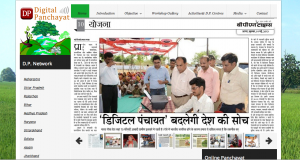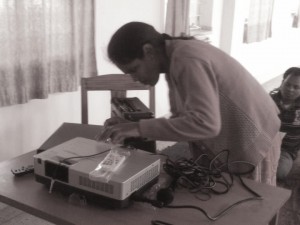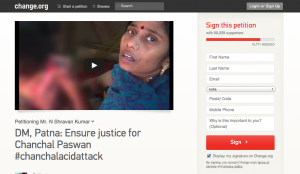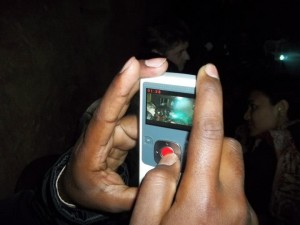As the director of an organization working on media reform at the intersection of online and offline activism, people often ask me to speak about what’s working and what’s not working when it comes to media and technology in rural areas. What impact is technology having on grassroots social change initiatives?
I find that technology has created a new kind of blinded elite. There’s a disconnect between the way global internet gurus boast about ‘universal access’ and ‘the technology revolution’ and how rural communities in developing countries access and produce it on the ground. There is a lot more focus on the ‘next billion’ coming online and a lot less on the ‘bottom billion’ coming online. Because the low-hanging fruit is so profitable to technology businesses, the telecom and Internet companies that could do so much to bring the poorest online are not really doing their part. So a lot of innovation geared at connecting the poor is coming from smaller technology start-ups (either for- or non-profit.) In the cases where the tech groups are able to actually access rural communities to implement their projects, these NGO/technology company partnerships offer a lot of hope. (I outline below some of the collaborations VV is part of below, by way of illustration.)
Some promising government initiatives: the Indian government is making efforts to connect villages to the Internet through  platforms like e-Panchayat. There are schemes for rolling out inexpensive tablets (approximately $60) called Aakash to students. But all of these initiatives are about ‘pushing’ information to communities and are rarely two-way. This needs to change. Because India still has high levels of illiteracy we need to invest in technologies – radio and video – that allow non-literates to produce knowledge. As the founding director of Video Volunteers I constantly ask myself -- how will our poorest and marginalised communities share their own, fully articulated thoughts and stories online? VV and other organizations are trying to enable this in rural India even before the Internet is really there. Wouldn’t it be nice if, when people finally come online, they find a media environment that is inclusive of their needs and interests instead of one that is alienating?
platforms like e-Panchayat. There are schemes for rolling out inexpensive tablets (approximately $60) called Aakash to students. But all of these initiatives are about ‘pushing’ information to communities and are rarely two-way. This needs to change. Because India still has high levels of illiteracy we need to invest in technologies – radio and video – that allow non-literates to produce knowledge. As the founding director of Video Volunteers I constantly ask myself -- how will our poorest and marginalised communities share their own, fully articulated thoughts and stories online? VV and other organizations are trying to enable this in rural India even before the Internet is really there. Wouldn’t it be nice if, when people finally come online, they find a media environment that is inclusive of their needs and interests instead of one that is alienating?
The mobile phone has huge potential for story gathering and reporting. Imagine if there was a phone number to report rural news and – most crucially - villagers knew about it and trusted its efficacy in terms of either getting the story public attention or getting action? Gram Vaani, an IIT based initiative, has set up such a network called Jharkhand Mobile Vaani that is one of the most successful in the country, and VV and Gram Vaani are starting to share stories on it.
[caption id="attachment_3118" align="alignleft" width="300"] Photo: CC Nirmala Ekka learns how to use the interactive DVDs created by Gram Vaani[/caption]
Photo: CC Nirmala Ekka learns how to use the interactive DVDs created by Gram Vaani[/caption]
An important part of the impact process for our correspondents is to screen the videos they create in their communities in order to get people talking about the issue. The process is often expensive and difficult to monitor. Gram Vaani is developing Interactive DVDs for us whereby people attending a screening can take a survey or a poll and can record messages about how an issue is affecting them. This will gather interesting data that can complement our videos and create a more powerful call to action when the campaign is shared with officials. Rocketalk and Radar are other interesting examples of mobile-based projects/platforms we may partner with (one for social networking and the other for citizen journalism) that are doing innovative things with mobile to connect urban and rural India.
Mobile Internet is slowly, very slowly, making its way into the communities where we work. Out of about 100 new people trained in the last two years, I’d say ten have arrived at a training session with a Facebook account enabled on their phone. The majority still have never heard of it, but that will change in time. Internet activism is good for some things, less good for others: The Internet is best to get people to act on specific targeted issues with a clearly definable target who can execute the change. Systemic change still needs masses of live grassroots organizing.
We’ve been working with change.org -- one of the world’s biggest online petition sites -- for about a year now. The petition launched for acid attack survivor, Chanchal, got an overwhelming response with over 50,000 signatures (and counting) demanding proper legal action against the culprits and medical treatment for Chanchal. It is currently one of the three biggest petitions on change.org in India. The officials in Bihar have had no choice but to sit up and listen to the 19 year old. A half hour TV program on the subject was broadcast, and several thousand dollars in donations have been raised from online viewers and Chanchal is getting much better medical care.
Over 86,000 people have signed on our online Change.org petitions in the last year. This has created impacts on the ground. I can give you documented examples of practices of untouchability being abolished in rural Rajasthan; teachers being paid in Jharkhand after 4 years; villagers in Gujarat receiving fluoride-free water; visually impaired people getting a bridge in Mumbai.
 For me these impacts are great examples of how NGOs can use technology to create change. Our partnerships with tech groups like Change.org and Gram Vaani have worked because they have the deep thinking on technology for development, and we have the ability to transfer this technology to local and rural communities in a meaningful and participatory fashion. We provide them with stories from grassroots India and they in turn are able to amplify those stories to a diverse Internet audience.
For me these impacts are great examples of how NGOs can use technology to create change. Our partnerships with tech groups like Change.org and Gram Vaani have worked because they have the deep thinking on technology for development, and we have the ability to transfer this technology to local and rural communities in a meaningful and participatory fashion. We provide them with stories from grassroots India and they in turn are able to amplify those stories to a diverse Internet audience.
My hope is that somewhere in the near future people in rural communities will be recording video on their phones and uploading it directly to the internet in large numbers. Imagine what organizations like VV – with one foot in villages and another in mainstream media houses – could do? There’s a lot of mystery, and that mystery is exciting. The demand to be heard and to contribute to the conversation has always been there in rural India, and now technology is catching up. We cannot afford to let so many millions to go unheard.
The happiness that comes with an yearly bonus
This video is a story of success, a story of a small win against a giant corporation. A story of persistence and a never-say-die attitude. This year, the workers of 3 gardens in the Alipurduar area of Kumargram Block, received a slightly increased yearly bonus, an increase of 3%, from...
#kNOwTrafficking – a campaign against human trafficking
Video Volunteers launched an online and offline campaign called “#kNOwTrafficking- Taskari Jaano, Taskaari Roko'' on July 18, 2022.

